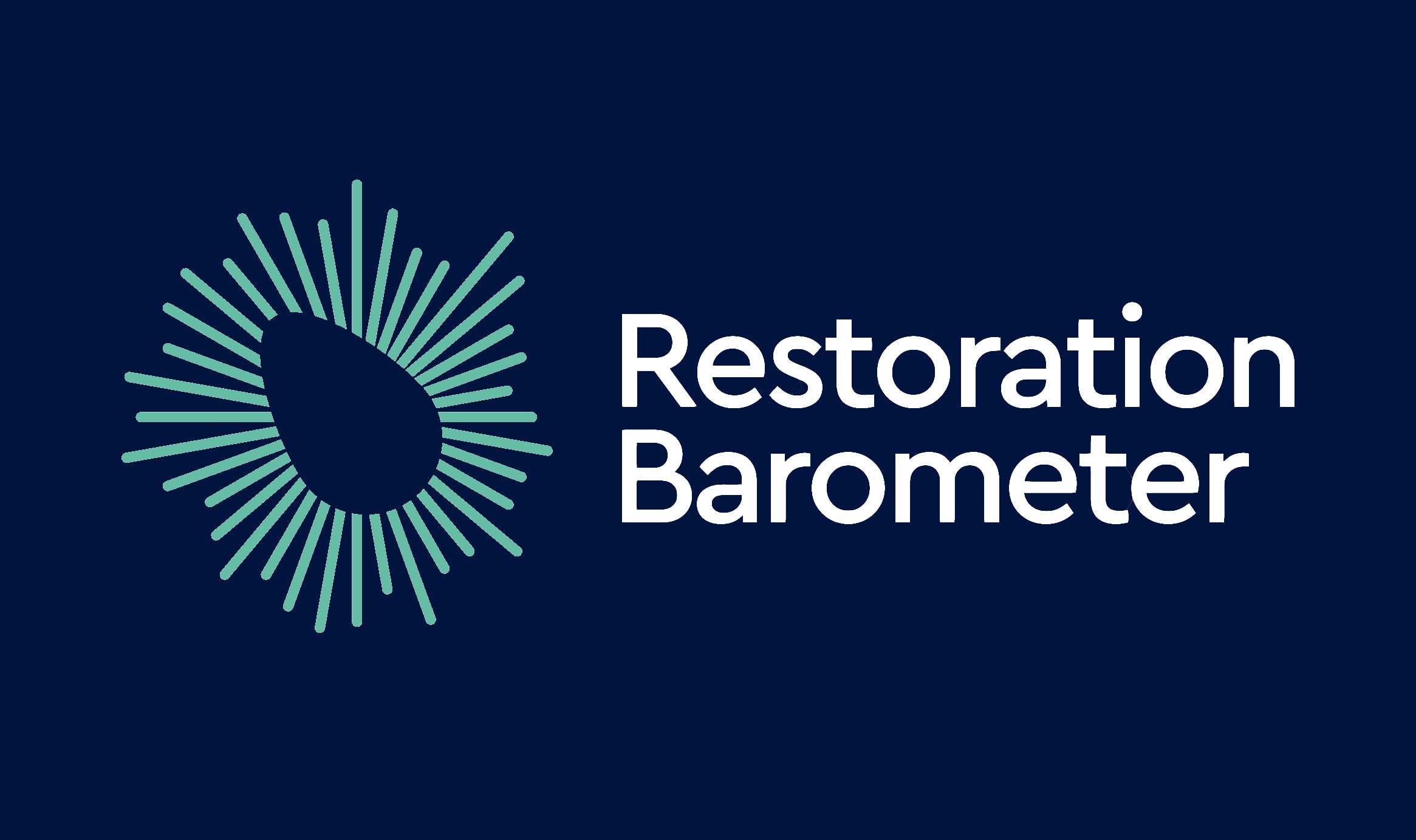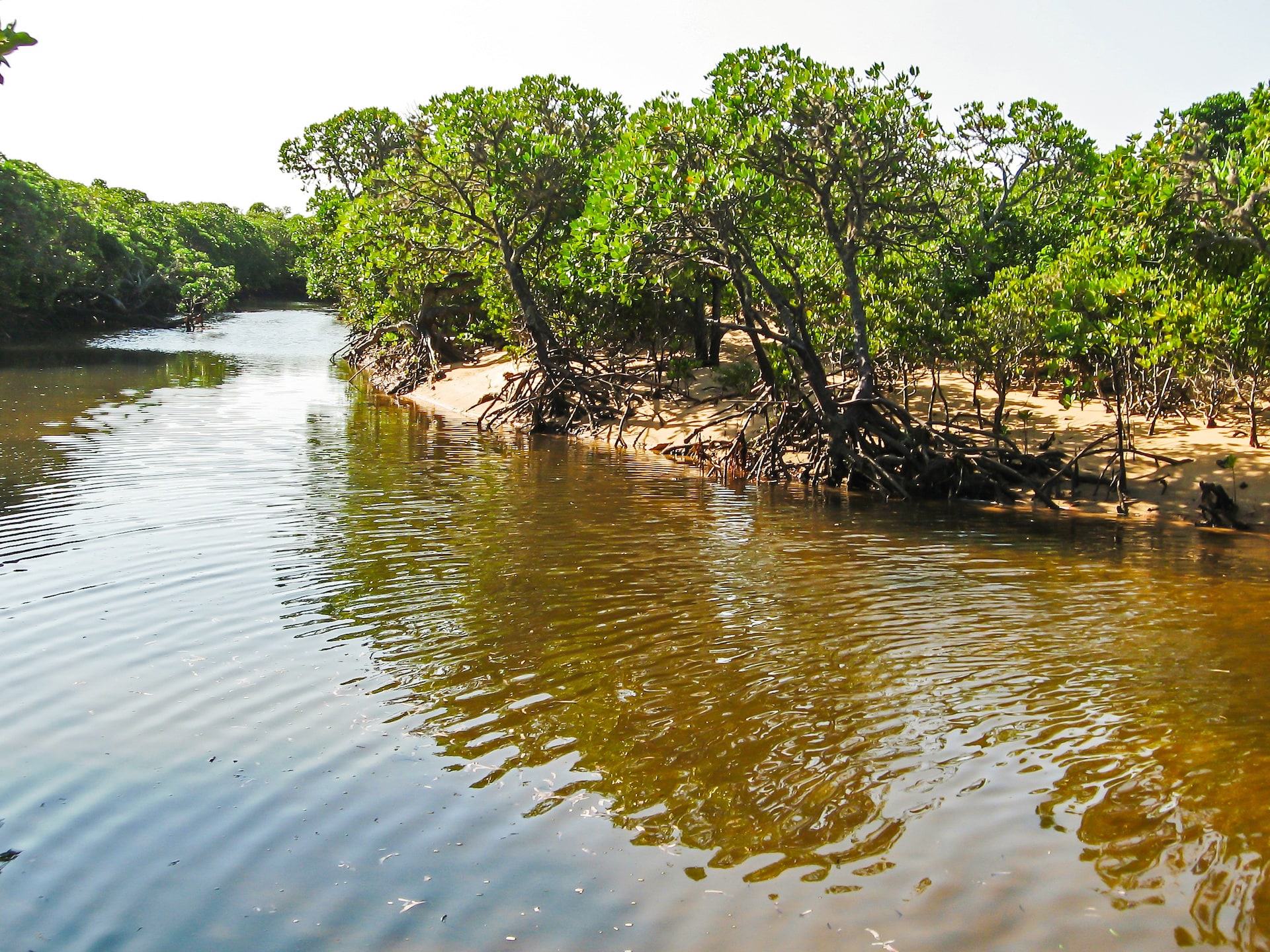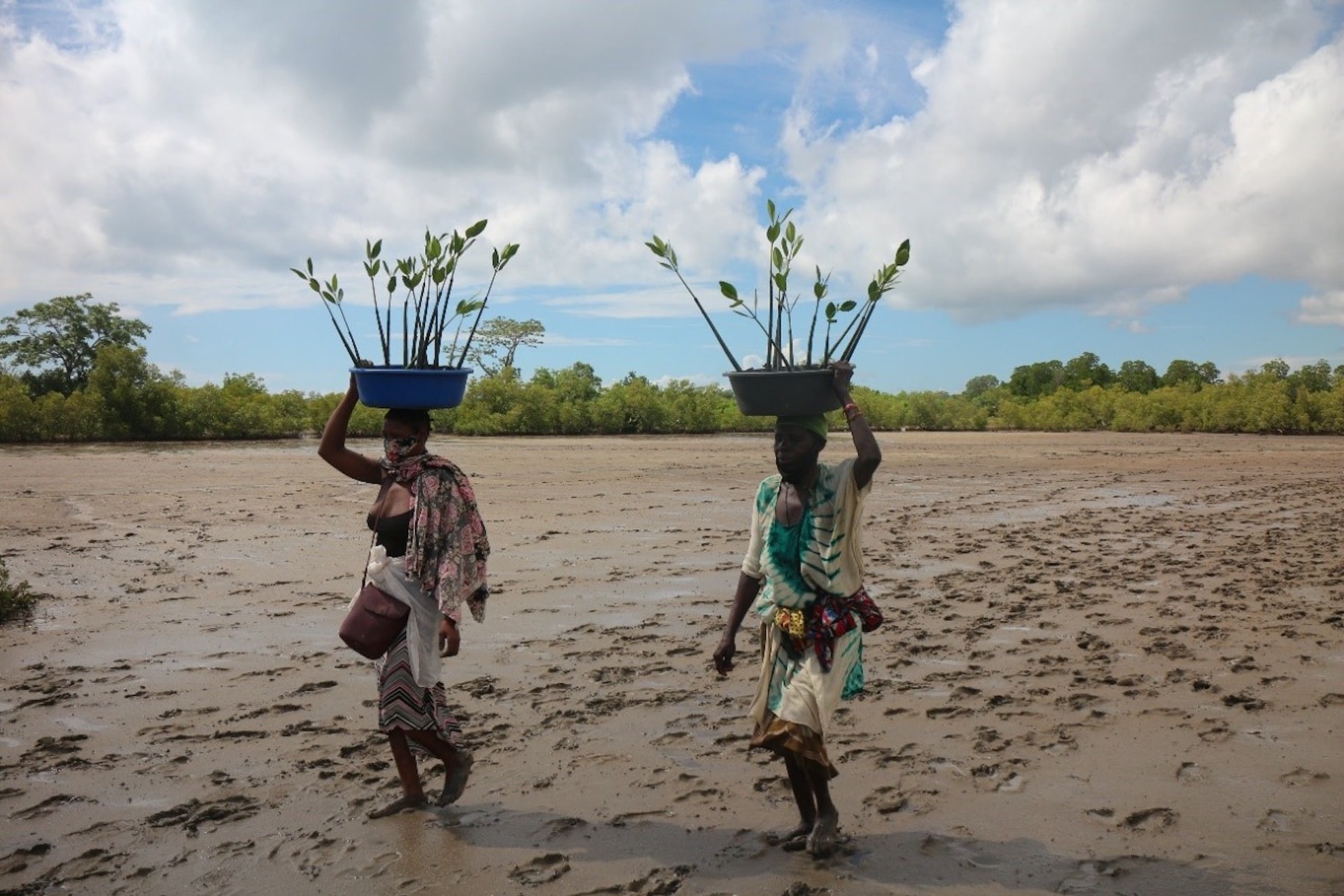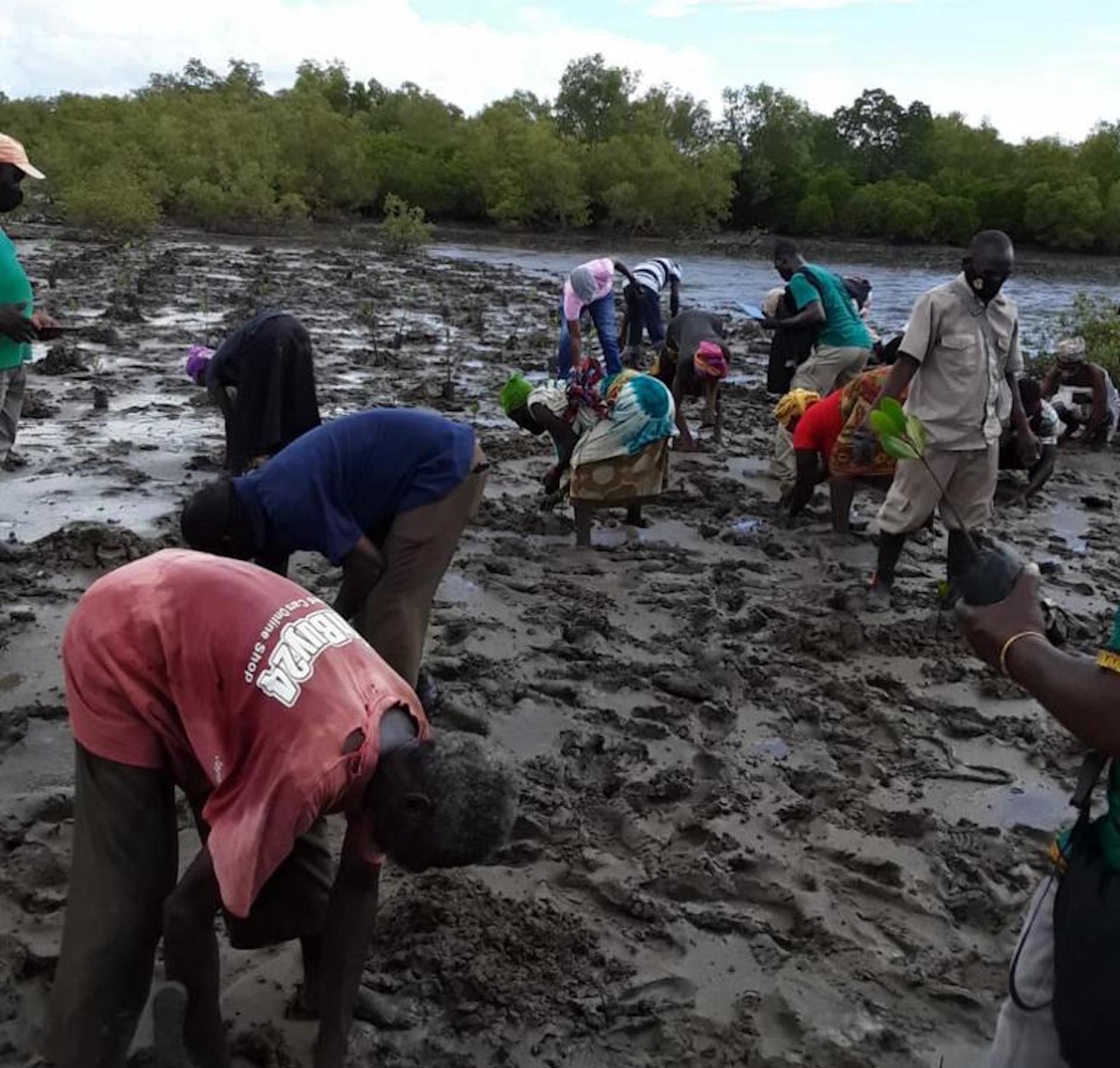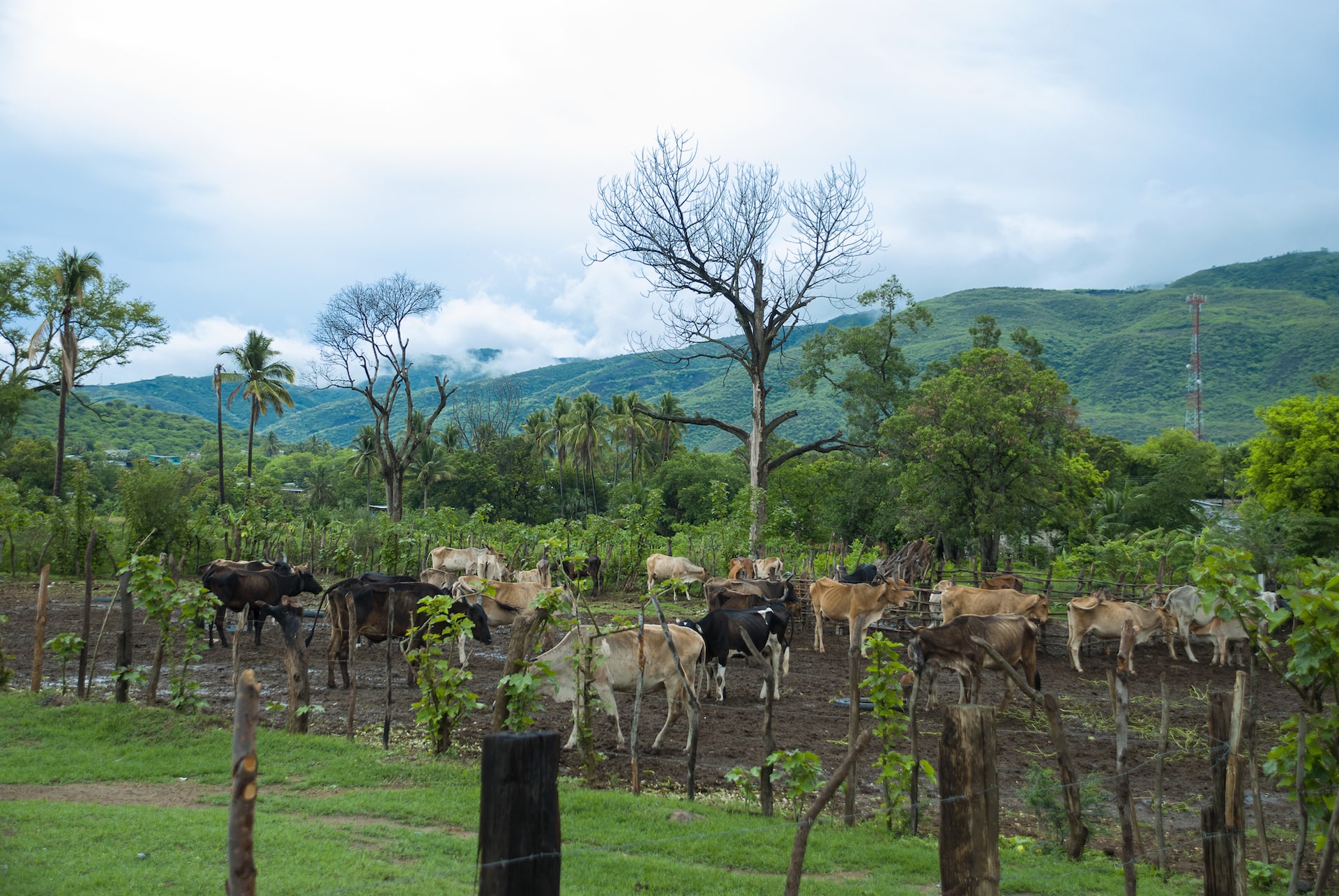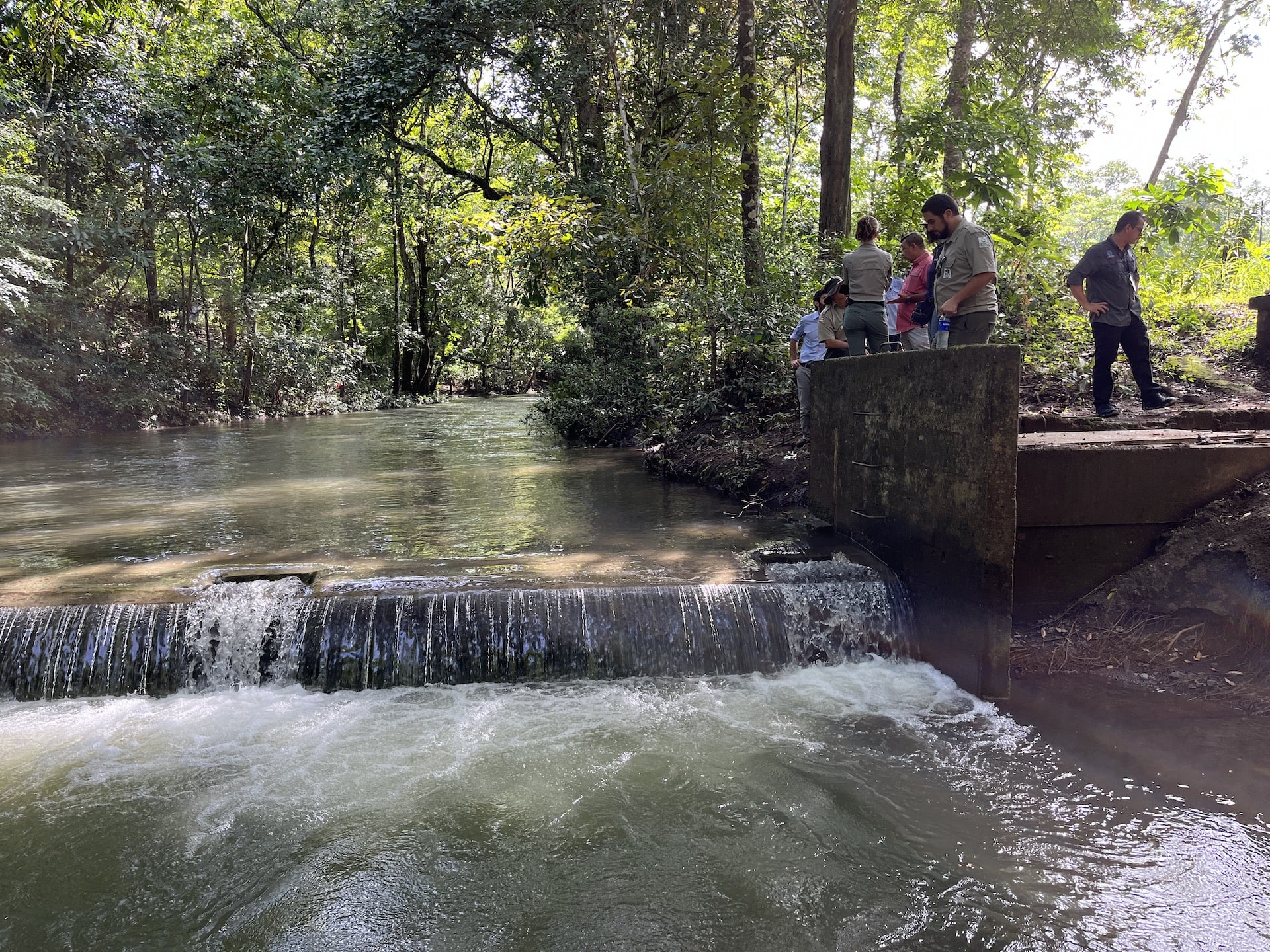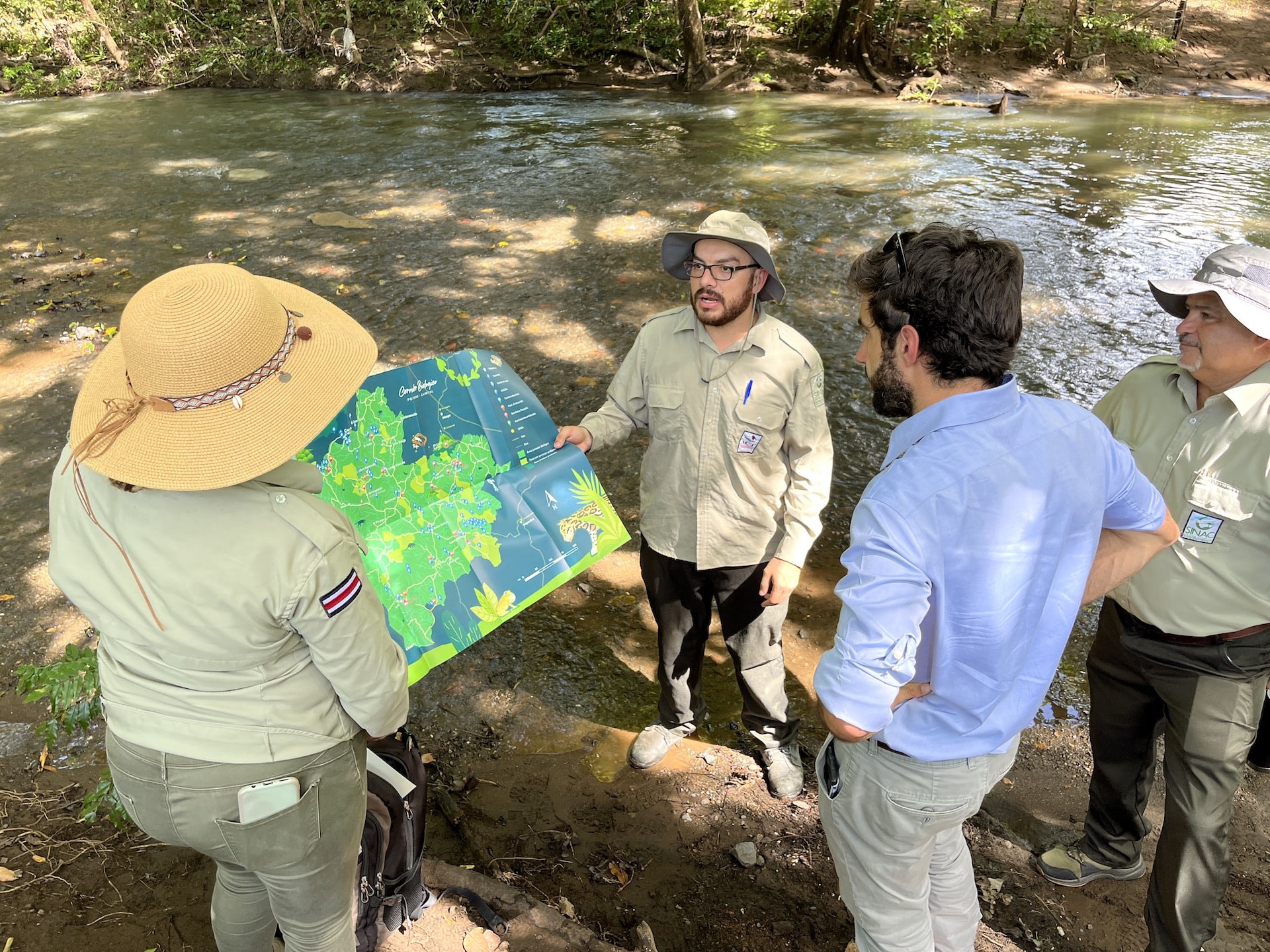Beginning the journey
What is the Restoration Barometer?
Establishing a vision
Laying the foundations of restoration
Beginning the journey
What is the Restoration Barometer?
The IUCN Restoration Barometer is the only functioning platform already being used by governments to track the progress of their restoration targets. It is currently used by 22 governments, endorsed by over 50, and was previously used by additional countries including the United States and Brazil. Data on over a dozen more countries will be uploaded in early 2023 and it is also being piloted for use by 34 companies.
Restoration refers to ecosystem restoration, which is the process of recovering ecosystems that have been damaged, degraded or destroyed. When done properly, restoration can increase biodiversity, improve livelihoods, enhance food security, increase water availability and help mitigate climate change, among many other benefits.
Many countries undergo restoration as part of their commitments to international goals or treaties such as the Bonn Challenge, Global Biodiversity Framework, Paris Agreement and more. By submitting data to the Barometer, countries are able to track the progress of their restoration targets in an easy, simple and streamlined way.
countries submitting their restoration data
22
types of ecosystems under restoration
8
million hectares of land pledged
>14
*The data is based on 18 countries whose submissions had been finalized by November 30, 2022. Data from additional countries is currently being processed.
“Restoration is an ongoing process. We developed the Restoration Barometer to empower our country partners to tell their chapters in that story. In this critical decade for restoration, the Barometer helps those restoring ecosystems to show the benefits of their work and secure much-needed resources for implementation.”
Carole Saint-Laurent, Team Head of the Forest and Grassland Team, Centre for Conservation Action, IUCN
Establishing a vision
Laying the foundations of restoration
Landscapes cannot be fully restored overnight. Restoration is a long-term process and looks different in each country depending on the needs of their unique ecosystems, environments and societies.
This means that each country must carefully plan how their restoration goals can be turned into real impact. To do this certain building blocks need to be put in place, including well-designed policies, thorough technical planning, sustained funding flows and robust monitoring systems.
Establishing these building blocks helps to contribute to the sustainability of countries’ restoration efforts and lay the foundations for as many benefits to be generated as possible, over time.
Policies
Establishing policies is a crucial part of the Restoration Journey. Countries can develop policies and other institutional arrangements which operationalise their restoration plan and help enable action on the ground. This may include, for example, setting a timeline, establishing incentive schemes, defining specific goals and laying out the approach to achieve these goals.
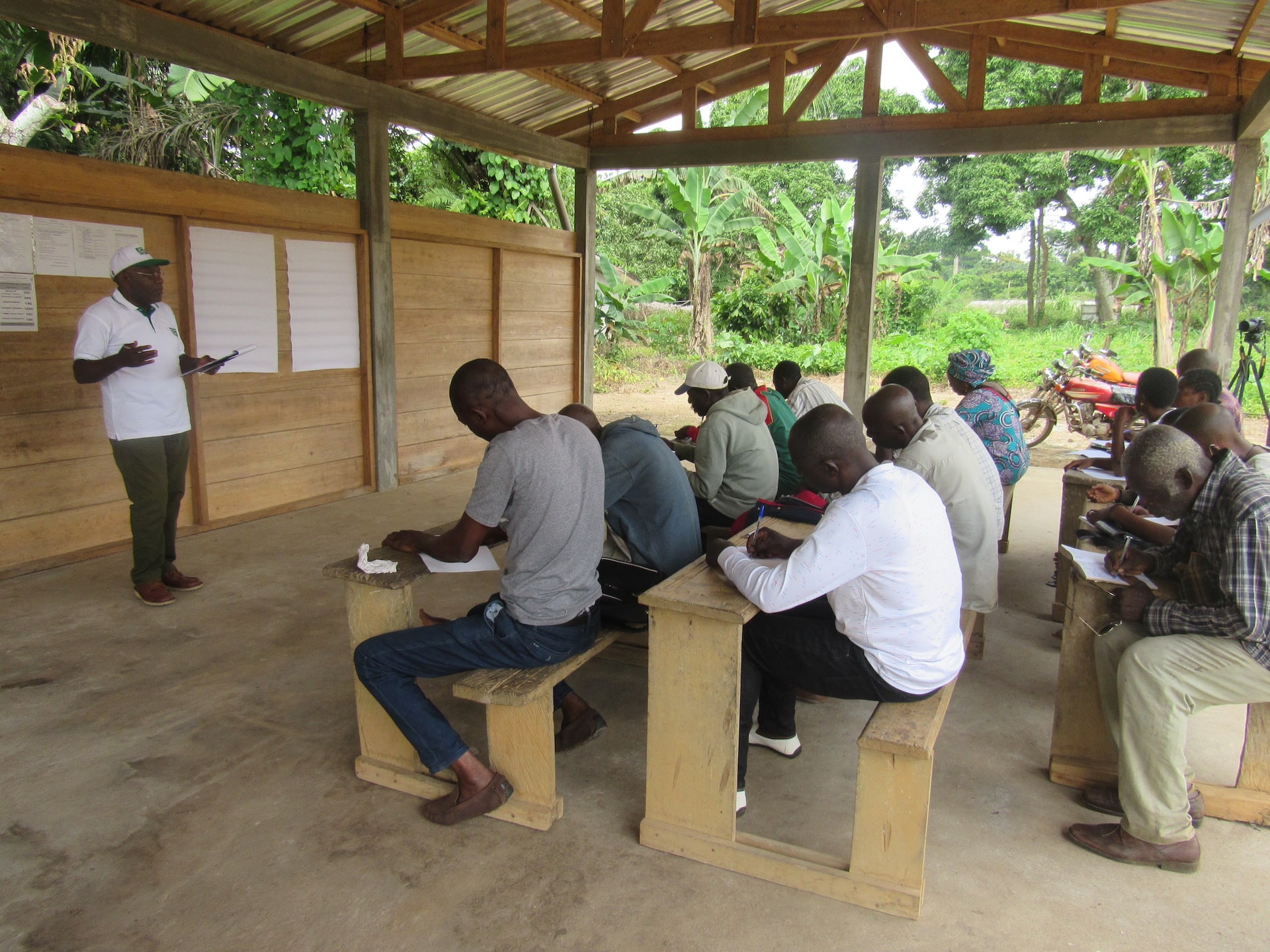
This process is crucial not only because it defines what the restoration goals are and how they can be achieved, but it also empowers government agencies and their partners to turn commitments into restoration action.
Mangrove strategy management in Mozambique
Planning
For good restoration to happen, certain tools and structures need to be put in place by governments. Before this can happen, effective planning is needed to identify where, why and how restoration efforts will take place.
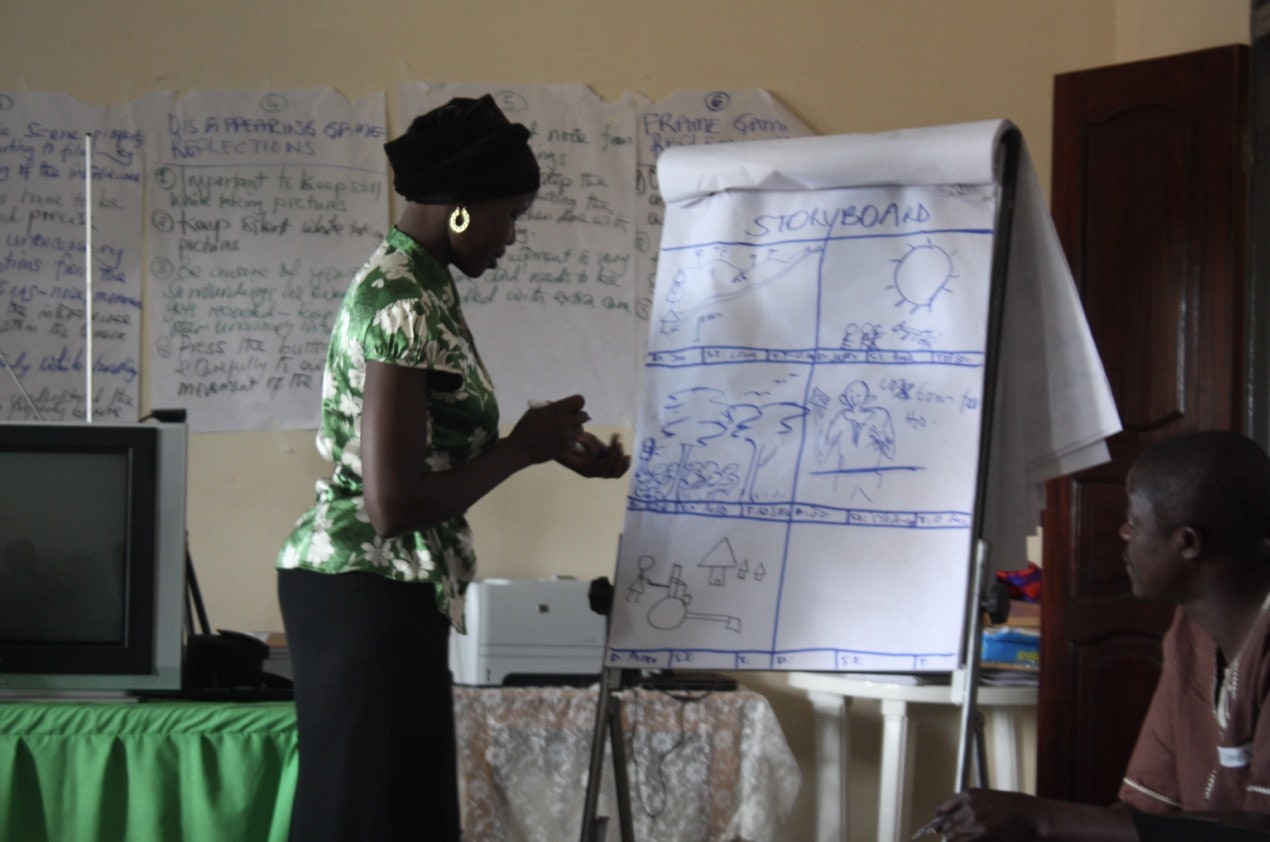
This makes sure that the right people are involved, the correct ecosystems are targeted and there is the right capacity to make restoration happen – thereby laying the foundations for real impact.
Restoration Planning in Central America – a planning case study
Making it happen
Laying the foundations of restoration
Making it happen
Laying the foundations for restoration
After establishing a vision, restoration plans must be implemented to ensure the goals come to life. Restoration looks different not only for each country but for each ecosystem. From planting mangroves and protecting coastlines, to reintroducing native species into wetlands and peatlands, restoration efforts come to fruition when people on the ground – who are invested in restoration – put plans into practice.
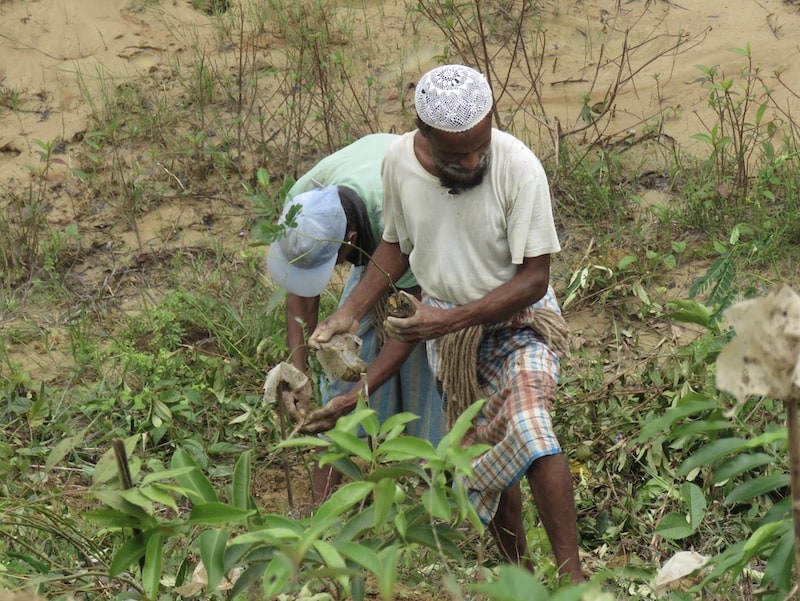
Monitoring
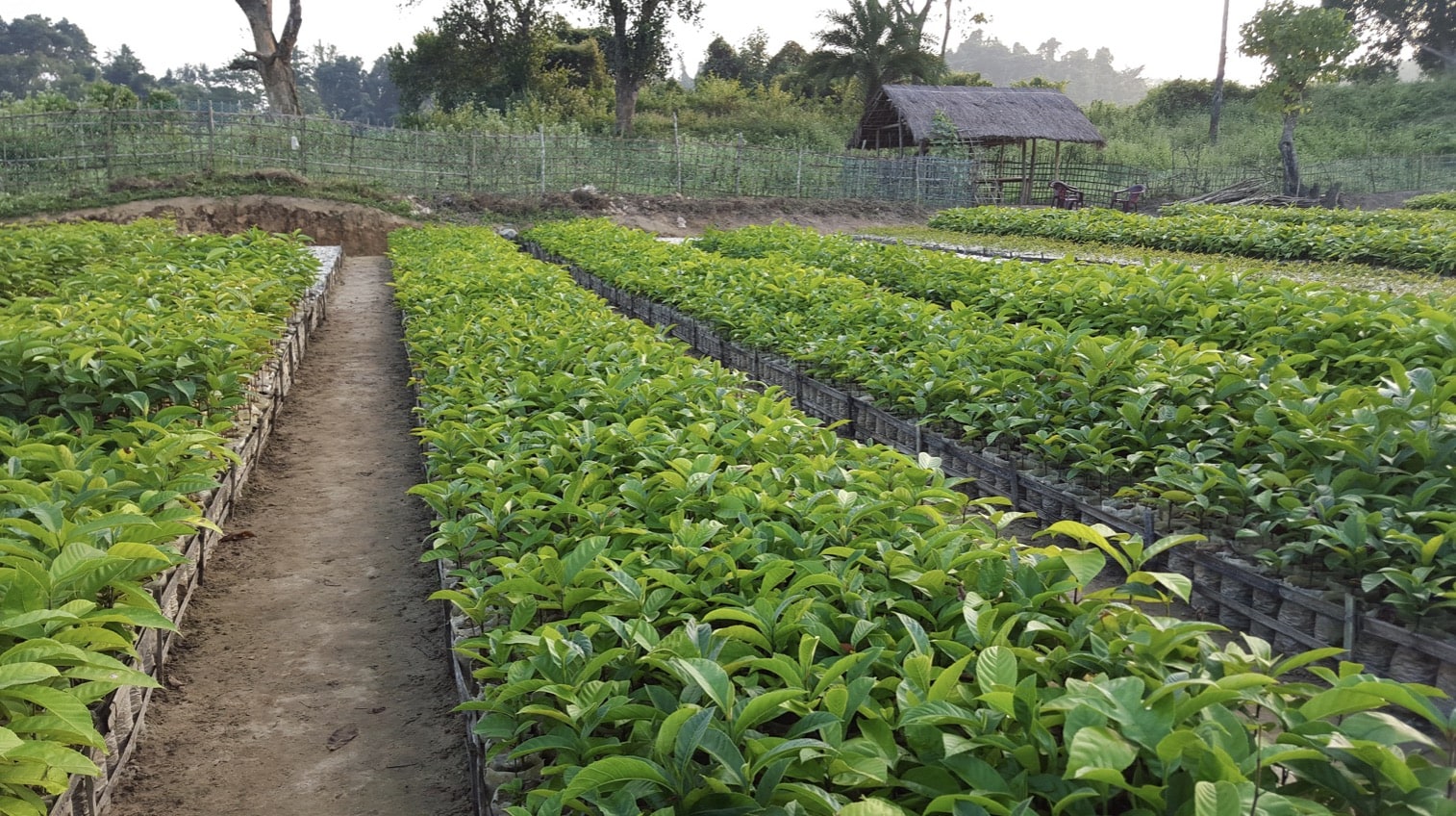
Implementing restoration is not the end of the journey; it is also important that restoration programmes are effectively monitored. By collecting data on restoration efforts over time, a picture can be built on whether positive progress is occurring, which can inform restoration approaches going forward. Alongside tracking data such as the number of trees or mangroves planted, biodiversity corridors created, or native species reintroduced, monitoring tools can also demonstrate community engagement with restoration projects.
Mapping forests in Kazakhstan – a monitoring case study
Kazakhstan is home to one of the largest forested areas in the European and Central Asian region, despite it covering just 5% of the country’s land. However, the forests remain under threat from climate change-related impacts such as drought and human activity such as the construction of roadways, poor resource management and polluting industries.
To address these threats and preserve the forests for future generations, the government is implementing national forest restoration schemes, with a goal of restoring 1.5 million hectares by 2030 and planting two billion trees.
Through nation-wide seeding and planting efforts, as well as the natural regeneration of individual tree species, over 575,000 hectares of land is currently under restoration across the country. Seasonal workers from local, mostly rural, populations, engage in these projects, planting forest crops and sowing seeds in forest nurseries.
While the implementation of restoration activities is underway, it is crucial to monitor progress to understand what is working and where more work needs to be done. In Kazakhstan, the government created an interactive map for the planting of two billion trees, which displays information such as the area being sowed or planted, species of trees, number of trees, as well as comprehensive plans for each stage. Spatial resolution imagery for the entire country is updated monthly, allowing for a comprehensive picture of the country’s restoration efforts.
Monitoring the implementation of restoration activities is an important step in making restoration happen and helps ensure its long-term success.
Rebuilding our ecosystems
Creating impact
Rebuilding our ecosystems
Creating impact
Once the foundations for restoration have been laid, ecosystems can begin to recover and the impact of restoration efforts will start to become visible. However, to see real and sustainable impact, it is crucial that restoration occurs across all ecosystems.
The Restoration Barometer covers all types of terrestrial ecosystems, including coastal and inland waters, where use or management rights can be identified. Currently, users of the Restoration Barometer can report on eight ecosystems…
Click the ecosystems to discover what they are and how they are being restored so far…
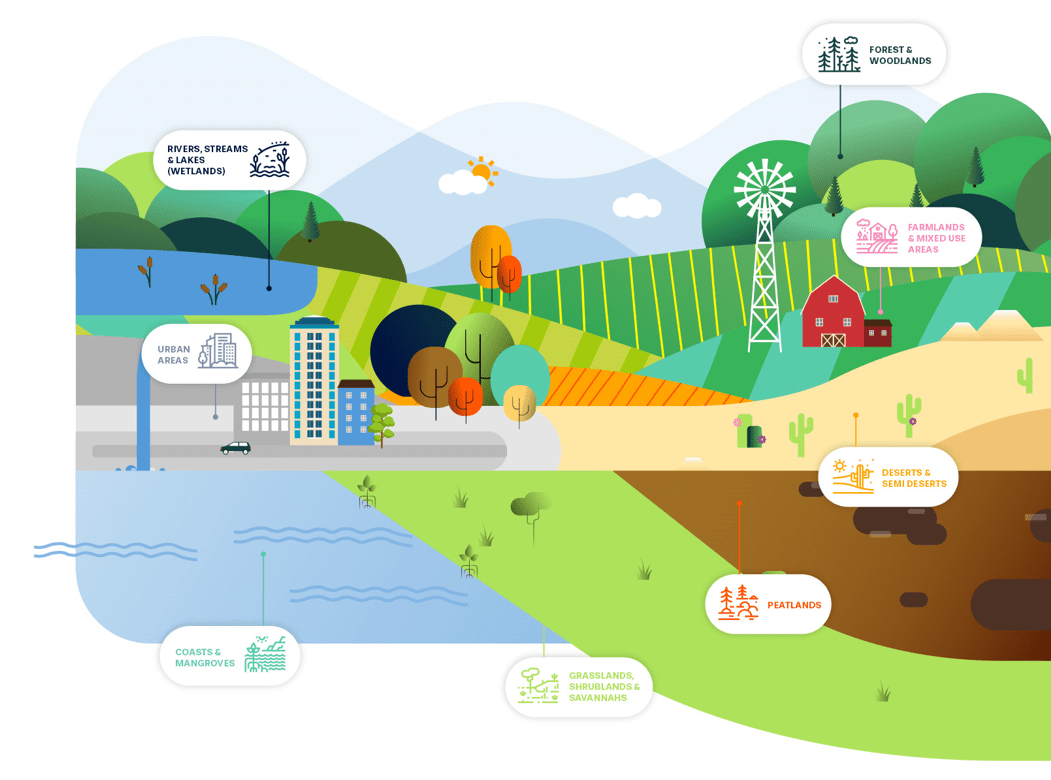
Deserts and Semi-deserts
Deserts and semi-deserts are landscapes where very little precipitation occurs, which creates conditions that are often hostile to plant and animal life. These hostile conditions are also exasperated by the onset of climate change, threatening life that is native to those regions.
This ecosystem can be restored through:
- Improving water access to native wildlife
- Natural regeneration (e.g., grazing and vegetation management, reintroduction of native species)
- Artificial regeneration (e.g., planting/seeding, terracing, interventions targeting water management or harvesting)
- Land and water protection (e.g., habitat protection)
- Invasive/problematic species control
- Management of invasive native species (including diseases)
8% of countries reporting to the Barometer in 2022 are currently restoring this ecosystem, across 1,554,132 hectares.
Farmlands and Mixed-use Areas
Farmlands are landscapes typically used for agricultural purposes, including rearing livestock and growing crops used for animal and human consumption. However, intensive agricultural practices often exhaust the land quality, causing water streams to be polluted, soil quality to deplete and biodiversity to dissipate.
This ecosystem can be restored through:
- Improving land management (e.g., agroforestry and organic farming)
- Artificial regeneration (e.g., crop rotation and integrated manure systems)
- Assisted natural regeneration (e.g., creating habitats and controlling pests)
- Farm landscapes (e.g., manage woodlots and restore riparian zones)
17% of countries using the Barometer are currently restoring this ecosystem, across 2,688,314 hectares.
Forests and Woodlands
Forests and woodlands are areas of land that are predominantly covered by trees and plant life. They are also home to a vast number of species. However, these ecosystems are threatened by deforestation for activities such as agriculture and mining, as well as extreme weather such as fires, which are becoming ever-more frequent due to climate change. Deforestation disturbs the balance of the plants and wildlife within these ecosystems and weakens natural functions such as soil health and water purification.
This ecosystem can be restored through:
- Land/ water protection/ conservation actions (e.g., habitat protection, planting/seeding and reintroducing wildlife)
- Natural regeneration (e.g., reducing or eliminating sources of degradation, restoring natural flooding regimes and soil improvement)
- Silviculture (e.g., replacing non-native species with native ones, retaining legacy trees and selective logging)
- Agroforestry
- Watershed protection and erosion control
- Invasive/problematic species control
28% of countries using the Barometer are currently restoring this ecosystem, across 8,785,373 hectares.
Peatlands
Peatlands refer to landscapes which consist mostly of peat or peat bogs. Peat is an organic layer of soil that is made from decayed vegetation and other organic matter and can store vast amounts of both carbon dioxide and water. However, the rising temperatures caused by climate change prevent peat from staying wet, which is problematic as dry peat releases significant amounts of carbon into the atmosphere.
This ecosystem can be restored through:
- Natural regeneration (e.g., removal of, non-native terrestrial vegetation, or overgrown native vegetation)
- Artificial regeneration (e.g., catchment management and prevention of illegal mining)
- Land / water protection
- Invasive/problematic species control
- Management of invasive native species (incl. diseases)
3% of countries using the Barometer are currently restoring this ecosystem, across 2,105 hectares.
Grasslands, Shrublands and Savannahs
Grasslands, shrublands and savannahs are typically arid or semi-arid and cover a vast amount of the world’s terrestrial surface. These landscapes are home to vegetation and soil which can capture and store carbon, as well as to a diverse number of species, many of which are endangered. Many of these ecosystems are also threatened by climate change through rising temperatures as well as unpredictable weather events.
This ecosystem can be restored through:
- Natural regeneration (e.g., cloud seeding and reviving herd movements)
- Artificial regeneration (e.g., shrub planting and soil augmentation)
- Land/water protection (e.g., habitat protection and corridor re-creation)
- Invasive/problematic species control
- Management of invasive native species (including diseases)
- Implementing participatory management systems and local land users
10% of countries using the Barometer are currently restoring this ecosystem, across 793,693 hectares.
Coasts and Mangroves
Coasts are landscapes that sit where the land meets the ocean and in some places, these include mangrove forests. Mangroves are unique shrubs or trees, with roots that often sit above water and land, that grow on coasts lines. Mangroves store carbon as well as having many other benefits to biodiversity. However due to climate change and human activity their numbers have been significantly depleting over the last few decades.
This ecosystem can be restored through:
- Natural regeneration
- Artificial regeneration
- Restore hydrology (e.g., dam removal and clear channel blockages)
- Site preparation
- Improving surface water quality (for seagrasses)
- Artificial fencing to prevent erosion and sand loss
- Land / water protection
15% of countries using the Barometer are currently restoring this ecosystem, across 98,373 hectares.
Rivers, Streams and Lakes (wetlands)
Found all over the planet across different climates, wetlands are landscapes where the soil is mostly saturated by water. These ecosystems are distinct in that they are not totally underwater, nor are they entirely dry landscapes.
This ecosystem can be restored through:
- Natural regeneration (e.g., reintroducing native species and removal of non-native terrestrial vegetation)
- Artificial regeneration (e.g., removal of unused or disused dams and prevention of illegal mining)
- Invasive/problematic species control
- Management of invasive native species (including diseases)
- Land / water protection
- Other
13% of countries using the Barometer are currently restoring this ecosystem, across 128,903 hectares.
Urban Areas
Urban areas are mostly artificial landscapes dominated by man-made structures such as buildings, roads and bridges. The development of these areas is often accompanied by a significant loss of vegetation and animals, unless plans are made to prevent this or reintroduce plants and animals elsewhere in the urban space.
This ecosystem can be restored through:
- Conversion of grey infrastructure to green
- Restoration of urban waterways
- Creation of blue spaces / semi-natural water reservoirs
- Improving air quality
- Creation of habitat for native species
- Creation of green roofs
- Development of peri-urban food systems
5% of countries using the Barometer are currently restoring this ecosystem, across 189,525 hectares.
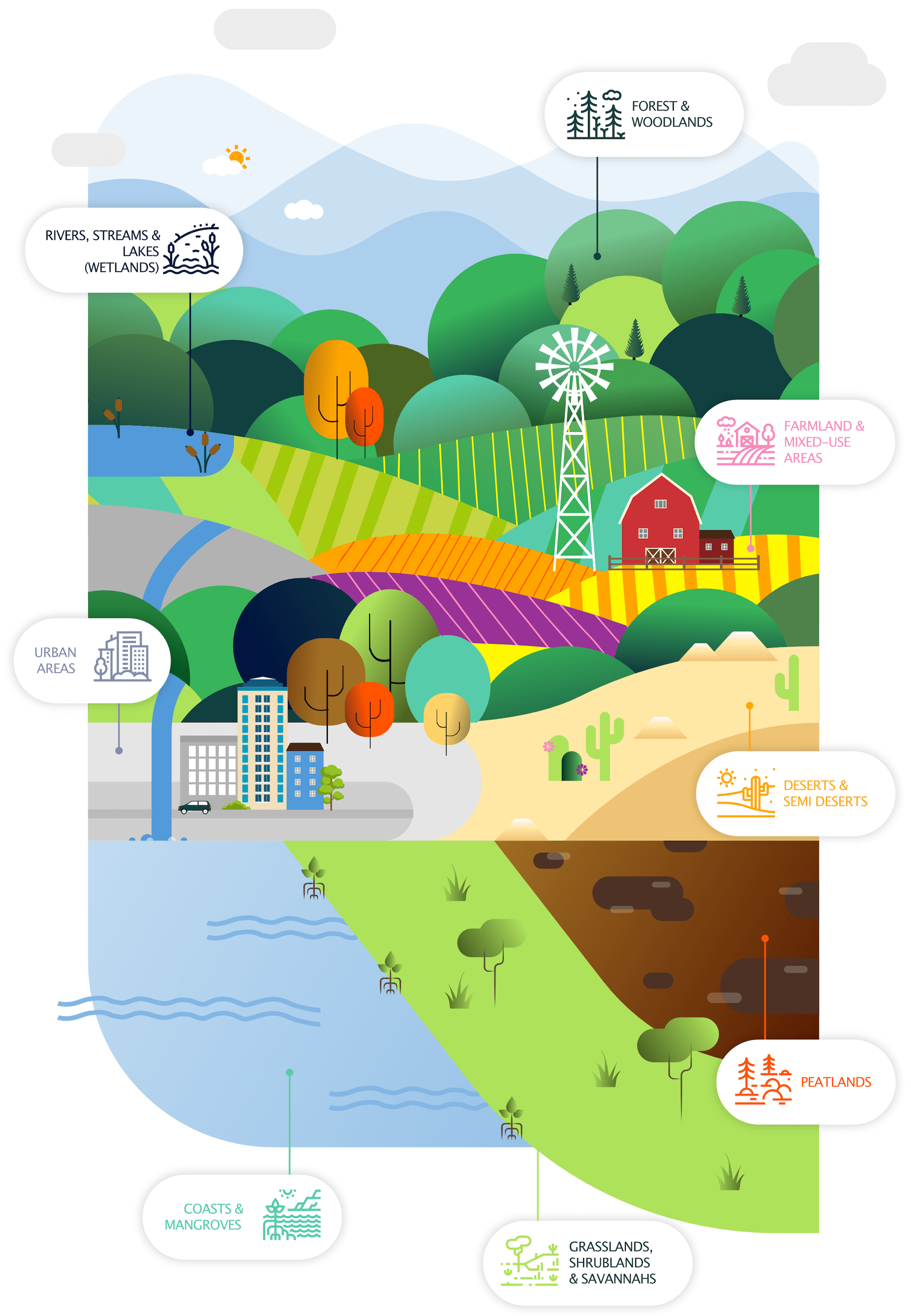
Deserts and Semi-deserts
Deserts and semi-deserts are landscapes where very little precipitation occurs, which creates conditions that are often hostile to plant and animal life. These hostile conditions are also exasperated by the onset of climate change, threatening life that is native to those regions.
This ecosystem can be restored through:
- Improving water access to native wildlife
- Natural regeneration (e.g., grazing and vegetation management, reintroduction of native species)
- Artificial regeneration (e.g., planting/seeding, terracing, interventions targeting water management or harvesting)
- Land and water protection (e.g., habitat protection)
- Invasive/problematic species control
- Management of invasive native species (including diseases)
8% of countries reporting to the Barometer in 2022 are currently restoring this ecosystem, across 1,554,132 hectares.
Farmlands and Mixed-use Areas
Farmlands are landscapes typically used for agricultural purposes, including rearing livestock and growing crops used for animal and human consumption. However, intensive agricultural practices often exhaust the land quality, causing water streams to be polluted, soil quality to deplete and biodiversity to dissipate.
This ecosystem can be restored through:
- Improving land management (e.g., agroforestry and organic farming)
- Artificial regeneration (e.g., crop rotation and integrated manure systems)
- Assisted natural regeneration (e.g., creating habitats and controlling pests)
- Farm landscapes (e.g., manage woodlots and restore riparian zones)
17% of countries using the Barometer are currently restoring this ecosystem, across 2,688,314 hectares.
Forests and Woodlands
Forests and woodlands are areas of land that are predominantly covered by trees and plant life. They are also home to a vast number of species. However, these ecosystems are threatened by deforestation for activities such as agriculture and mining, as well as extreme weather such as fires, which are becoming ever-more frequent due to climate change. Deforestation disturbs the balance of the plants and wildlife within these ecosystems and weakens natural functions such as soil health and water purification.
This ecosystem can be restored through:
- Land/ water protection/ conservation actions (e.g., habitat protection, planting/seeding and reintroducing wildlife)
- Natural regeneration (e.g., reducing or eliminating sources of degradation, restoring natural flooding regimes and soil improvement)
- Silviculture (e.g., replacing non-native species with native ones, retaining legacy trees and selective logging)
- Agroforestry
- Watershed protection and erosion control
- Invasive/problematic species control
28% of countries using the Barometer are currently restoring this ecosystem, across 8,785,373 hectares.
Peatlands
Peatlands refer to landscapes which consist mostly of peat or peat bogs. Peat is an organic layer of soil that is made from decayed vegetation and other organic matter and can store vast amounts of both carbon dioxide and water. However, the rising temperatures caused by climate change prevent peat from staying wet, which is problematic as dry peat releases significant amounts of carbon into the atmosphere.
This ecosystem can be restored through:
- Natural regeneration (e.g., removal of, non-native terrestrial vegetation, or overgrown native vegetation)
- Artificial regeneration (e.g., catchment management and prevention of illegal mining)
- Land / water protection
- Invasive/problematic species control
- Management of invasive native species (incl. diseases)
3% of countries using the Barometer are currently restoring this ecosystem, across 2,105 hectares.
Grasslands, Shrublands and Savannahs
Grasslands, shrublands and savannahs are typically arid or semi-arid and cover a vast amount of the world’s terrestrial surface. These landscapes are home to vegetation and soil which can capture and store carbon, as well as to a diverse number of species, many of which are endangered. Many of these ecosystems are also threatened by climate change through rising temperatures as well as unpredictable weather events.
This ecosystem can be restored through:
- Natural regeneration (e.g., cloud seeding and reviving herd movements)
- Artificial regeneration (e.g., shrub planting and soil augmentation)
- Land/water protection (e.g., habitat protection and corridor re-creation)
- Invasive/problematic species control
- Management of invasive native species (including diseases)
- Implementing participatory management systems and local land users
10% of countries using the Barometer are currently restoring this ecosystem, across 793,693 hectares.
Coasts and Mangroves
Coasts are landscapes that sit where the land meets the ocean and in some places, these include mangrove forests. Mangroves are unique shrubs or trees, with roots that often sit above water and land, that grow on coasts lines. Mangroves store carbon as well as having many other benefits to biodiversity. However due to climate change and human activity their numbers have been significantly depleting over the last few decades.
This ecosystem can be restored through:
- Natural regeneration
- Artificial regeneration
- Restore hydrology (e.g., dam removal and clear channel blockages)
- Site preparation
- Improving surface water quality (for seagrasses)
- Artificial fencing to prevent erosion and sand loss
- Land / water protection
15% of countries using the Barometer are currently restoring this ecosystem, across 98,373 hectares.
Rivers, Streams and Lakes (wetlands)
Found all over the planet across different climates, wetlands are landscapes where the soil is mostly saturated by water. These ecosystems are distinct in that they are not totally underwater, nor are they entirely dry landscapes.
This ecosystem can be restored through:
- Natural regeneration (e.g., reintroducing native species and removal of non-native terrestrial vegetation)
- Artificial regeneration (e.g., removal of unused or disused dams and prevention of illegal mining)
- Invasive/problematic species control
- Management of invasive native species (including diseases)
- Land / water protection
- Other
13% of countries using the Barometer are currently restoring this ecosystem, across 128,903 hectares.
Urban Areas
Urban areas are mostly artificial landscapes dominated by man-made structures such as buildings, roads and bridges. The development of these areas is often accompanied by a significant loss of vegetation and animals, unless plans are made to prevent this or reintroduce plants and animals elsewhere in the urban space.
This ecosystem can be restored through:
- Conversion of grey infrastructure to green
- Restoration of urban waterways
- Creation of blue spaces / semi-natural water reservoirs
- Improving air quality
- Creation of habitat for native species
- Creation of green roofs
- Development of peri-urban food systems
5% of countries using the Barometer are currently restoring this ecosystem, across 189,525 hectares.
Benefits for biodiversity
Creating impact
Supporting livelihoods
Creating impact
Looking to the future
What is next for the Restoration Barometer
Benefits to biodiversity
Creating impact
Ecosystems, species and biodiversity are deeply interconnected. When ecosystems endure degradation and destruction, species are often endangered, reducing diversity and weakening ecosystems further. Without a wide range of animals, plants and microorganisms, ecosystem health suffers.
To specifically track the impact of restoration on Red List species, countries using the Restoration Barometer report on the amount hectares they have under restoration that they anticipate will also help to protect and improve the status of threatened species. They are also encouraged to identify specific species that have benefitted from restoration efforts.
Use the map below to discover how restoration has helped protect endangered species...

Ghana
Example of red list species protected through restoration:
- Rosewood (tropical timber endemic to some countries in Africa)
- Talbotiella gentii (a medium-sized forest tree, endemic to Ghana)
- Afromosia (African teak)
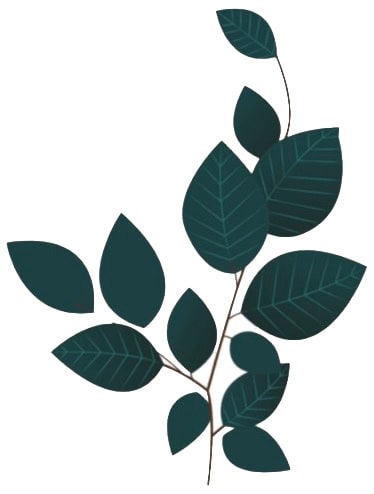
Ghana
Example of red list species protected through restoration:
- Rosewood (tropical timber endemic to some countries in Africa)
- Talbotiella gentii (a medium-sized forest tree, endemic to Ghana)
- Afromosia (African teak)

Mexico
Example of red list species protected through restoration:
- Mexican alligator lizard (Abronia gramínea)
- Mantled howler monkey (Alouatta palliata)
- American crocodile (Crocodylus acutus)
- Mexican pigmy rattlesnake (Crotalus ravus)
- Mexican prairie dog (Cynomys mexicanus)
- Ocelot (Leopardus pardalis)
- Margay (Leopardus wiedii)
- Jaguar (Panthera onca)

Mexico
Example of red list species protected through restoration:
- Mexican alligator lizard (Abronia gramínea)
- Mantled howler monkey (Alouatta palliata)
- American crocodile (Crocodylus acutus)
- Mexican pigmy rattlesnake (Crotalus ravus)
- Mexican prairie dog (Cynomys mexicanus)
- Ocelot (Leopardus pardalis)
- Margay (Leopardus wiedii)
- Jaguar (Panthera onca)

Peru
Example of red list species protected through restoration:
- American carob (Algarrobo "Prosopis pallida")
- Mahogany (Caoba "Swietenia macrophylla")
- Spanish/Cuban cedar (Cedro "Cedrella odorata")

Peru
Example of red list species protected through restoration:
- American carob (Algarrobo "Prosopis pallida")
- Mahogany (Caoba "Swietenia macrophylla")
- Spanish/Cuban cedar (Cedro "Cedrella odorata")

Kazakhstan
Example of red list species protected through restoration:
- Turkestan lynx (Eurasian lynx endemic only to mountain ranges in Central Asia)
- Snow Leopard (felid endemic to mountain ranges in South and Central Asia)
- Himalayan brown bear (subspecies of the brown bear endemic to many countries in Asia)
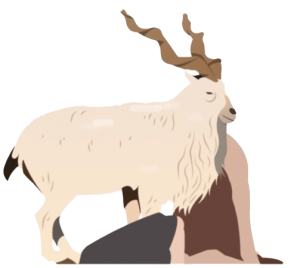
Kazakhstan
Example of red list species protected through restoration:
- Turkestan lynx (Eurasian lynx endemic only to mountain ranges in Central Asia)
- Snow Leopard (felid endemic to mountain ranges in South and Central Asia)
- Himalayan brown bear (subspecies of the brown bear endemic to many countries in Asia)

Rwanda
Example of red list species protected through restoration:
- Chinaberry (Melia azedarach)
- African cherry (Prunus Africana)
- African sandalwood (Osyris lanceolata)
- Koto (Pterygota macrocarpa)
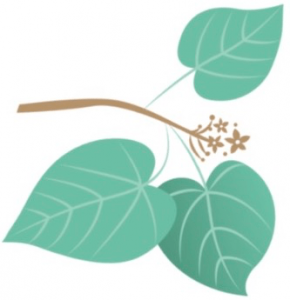
Rwanda
Example of red list species protected through restoration:
- Chinaberry (Melia azedarach)
- African cherry (Prunus Africana)
- African sandalwood (Osyris lanceolata)
- Koto (Pterygota macrocarpa)

Tajikistan
Example of red list species protected through restoration:
- Darvaz plum (Prunus darvasica Temberg)
- Markhor (Carpa falconeri Wagner)

Tajikistan
Example of red list species protected through restoration:
- Darvaz plum (Prunus darvasica Temberg)
- Markhor (Carpa falconeri Wagner)

The IUCN Red List
The IUCN Red List is the world’s most comprehensive information source on the global extinction risk status of animal, fungus and plant species. It is a critical indicator of the health of the world’s biodiversity and provides key information that will help inform necessary conservation decisions.
Supporting livelihoods
Creating impact
While restoring ecosystems is at the heart of restoration, human involvement is an integral part of many restoration efforts.
This means people and communities experience additional benefits that go beyond ecosystem goods and services and enhanced biodiversity. In many cases, jobs are created, which not only has a knock-on effect for local economies, but can also lead to improved education and up-skilling, as people learn new ways of creating an income.
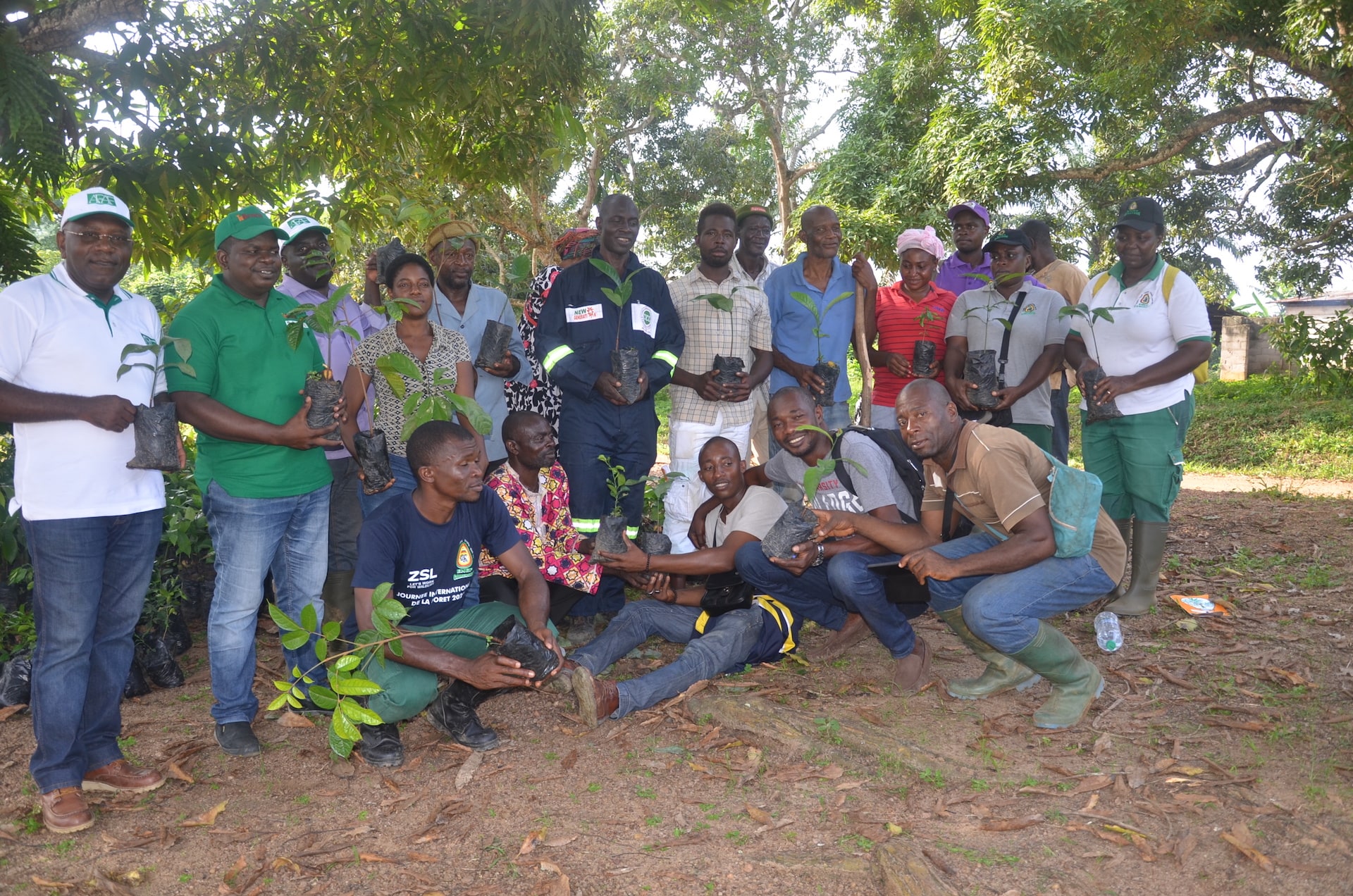
But beyond job creation, restoration plays an integral role in wider sustainable development efforts. This includes enhancing food security and dietary diversity, increasing water availability, supplying wood energy for cooking and contributing to better health.
Livelihoods created through restoration
The type of jobs created by restoration efforts will vary by project or scheme. This can include jobs directly linked to the restoration efforts, such as farmer-assisted natural regeneration and replacing non-native species with native species to increase diversity; jobs linked to wider project goals, such as building houses; and income generated from new, alternative livelihoods, such as seed selling.
Jobs will also vary in length, with some being casual or seasonal work and others being long-term, full-time jobs. Both are important in generating benefits to society more widely, but the latter in particular is a marker of how restoration projects can contribute to the development of green jobs and a more sustainable economy within a country.
In Rwanda, 827,940 jobs have been created through a number of restoration projects (as of 2022). The sustainable forestry project Green Gicumbi, located in Gicumbi District in Rwanda’s Northern Province, focuses on building the resilience of vulnerable communities to climate change. Alongside rehabilitating forests, climate resilient houses are being built by local people, cookstoves distributed and alternative incomes established within communities.
Meanwhile in the Kyrgyz Republic, as part of a national campaign to restore and conserve forest ecosystems, employees of the Ministry of Agriculture and participants of the youth association “Students for Green Economy” planted 1,400 apple tree seedlings across five hectares and 4,400 coniferous seedlings across 6.5 hectares. As well as the planting work, participants in the campaign benefit from learning additional skills and building knowledge on ecosystems and restoration methods.
Job Creation
12,863,925 jobs created through restoration
-
10,620,148 jobs in Africa
-
43,983 jobs in Asia
-
2,199,794 jobs in Latin America
-
4,269,315 long term jobs
-
3,114,978 seasonal, casual or occasional jobs
-
4,487,269 short term jobs
-
992,363 other
Looking to the future
What is next for the Restoration Barometer
The restoration of ecosystems is a critical part of our journey to a safe climate and liveable future. The Restoration Barometer is a tool which enables countries to track progress and inspire action on their journey to restoration. By ensuring the building blocks for successful restoration are established, hugely beneficial impacts across ecosystems, biodiversity and livelihoods can be realised.
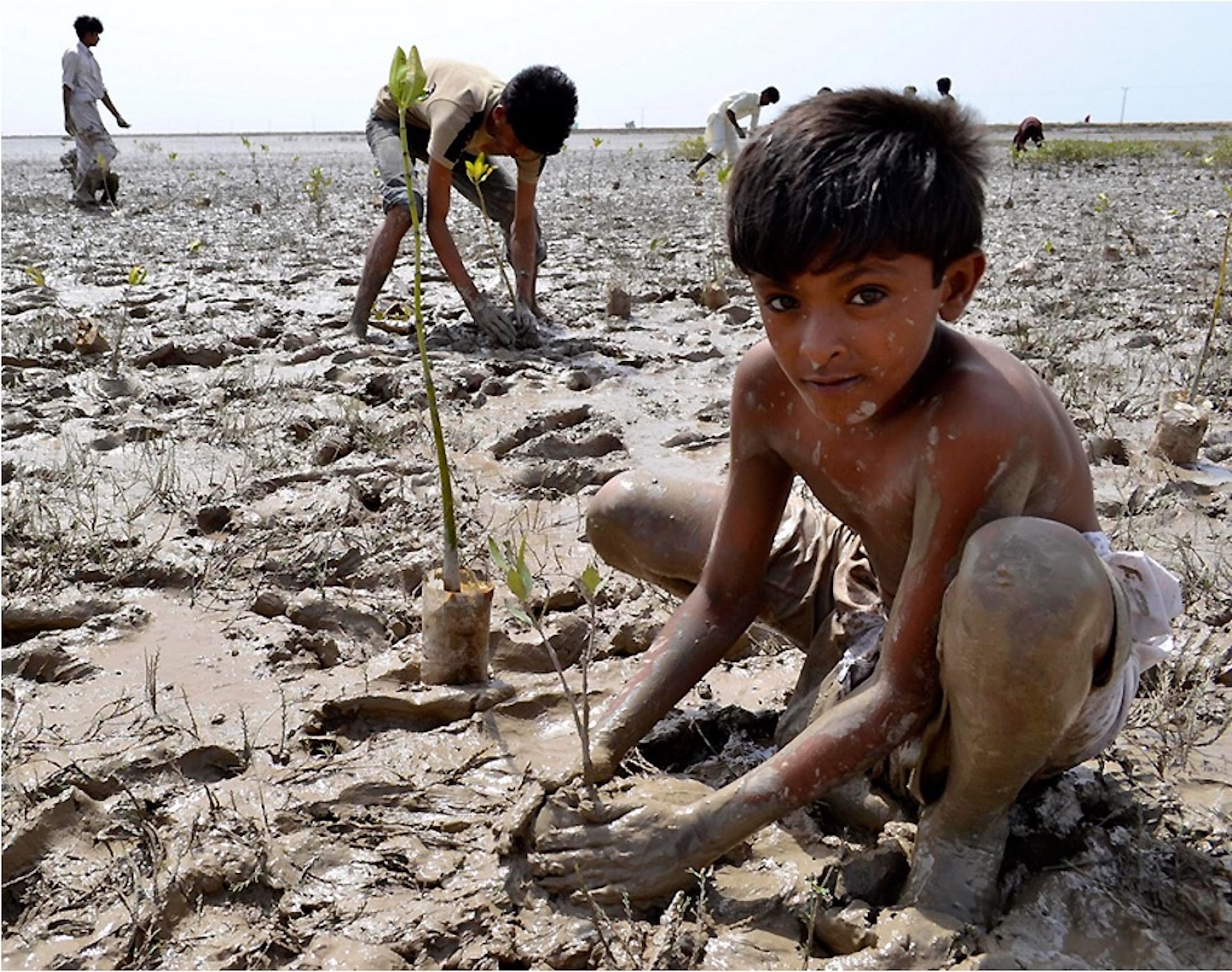
Going forward, the private sector will also be using the Barometer to help build a comprehensive picture of their restoration efforts and commitments, including any benefits stemming from implementation. This tool can enable them to demonstrate their commitment to driving positive social and environmental change, as well as account for it.
The Barometer will help governments, associations and businesses assess where and how their resources should be allocated. It can also help identify policies and incentives needed to unlock transformative restoration action.

Download the Full Report

Celebrate Restoration on Social Media

Visit the Restoration Barometer Website
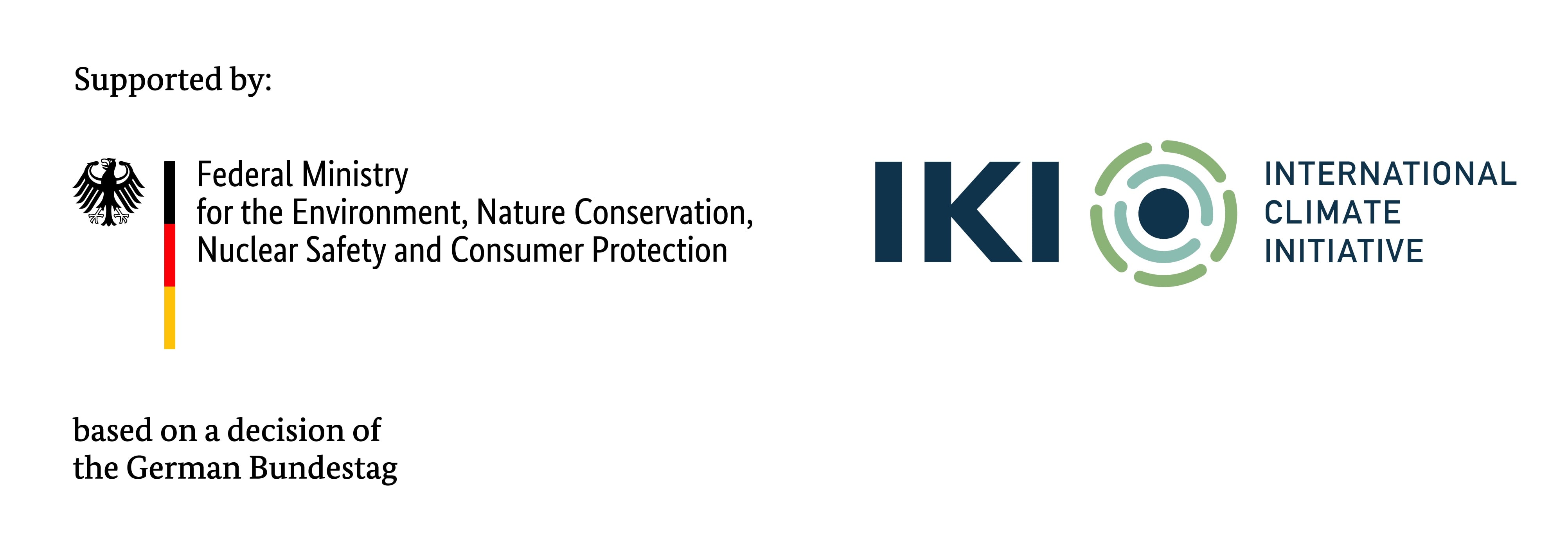

Terms and conditions
